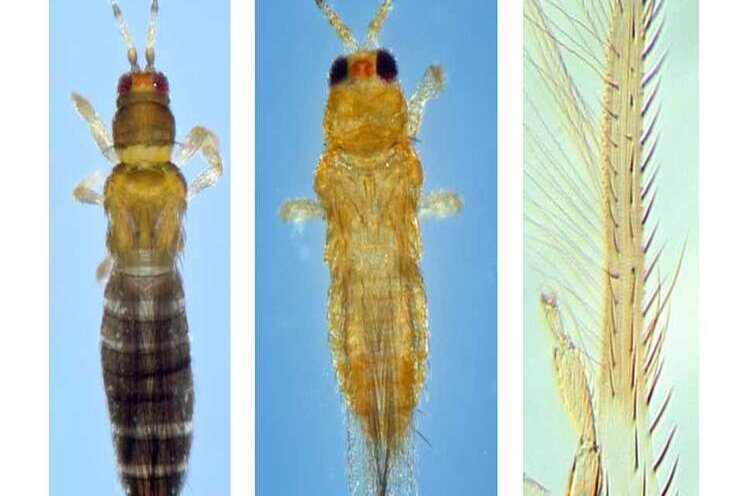Plant growers beware! Another exotic pest has arrived
Added on 11 November 2020

This species is native to the Asian tropics. However, during the last 20 years, the species has been expanding its range and is now found in Greece, France, Spain, The Netherlands, Tanzania, Mauritius, Reunion, and Hawaii.

[From left] Adult female Thrips parvispinus. Adult male T. parvispinus. Female T. parvispinus forewing. Photos by Felipe N. Soto-Adames, FDACS-DPI
According to FDACS-DPI officials, barcode sequences from specimens collected in Orange County, FL, are identical to those found in Thrips parvispinus populations in Indonesia.
T. parvispinus feeds on many plants, but it is most damaging to ornamentals in Europe and Indonesia, papaya in Hawaii and Indonesia, as well as peppers and other solanaceous crops in Indonesia.

Anthurium leaf damage from T. parvispinus, dorsal view.
Photo by Felipe N. Soto-Adames, FDACS-DPI
[From left] Adult female Thrips parvispinus. Adult male T. parvispinus. Female T. parvispinus forewing. Photos by Felipe N. Soto-Adames, FDACS-DPI
FDACS-DPI recently sent posted a Pest Alert regarding T. parvispinus, which includes the following specs:
IDENTIFICATION: Females and males differ in size and color. Females are nearly 1 mm long, with brown head and prothorax, yellowish brown meso- and metathorax and black abdomen; forewings are dark, with light-colored base; the third antennal segment and the base of the fourth and fifth segments are light colored (either yellow or white). Males are 0.6 mm long and evenly yellow.

Anthurium leaf damage from T. parvispinus, ventral view.
Photo by Felipe N. Soto-Adames, FDACS-DPI
In Anthurium, the thrips is found on either side of leaves. In Hoya, individuals can be seen wandering all over the plant, but tend to concentrate on growing buds. The minute size of the species makes it difficult to detect, even when damage to plants is evident.
HOSTS AND DAMAGE: T. parvispinus is polyphagous with the preferred hosts varying across its geographic distribution. In regions where the species has been long established, the crops most affected are papaya, peppers, potatoes, eggplants, beans, shallots, and strawberries. In Indonesia, field pepper yield losses due to T. parvispinus reach 23%.

Hoya, damage to buds by T. parvispinus.
Photo by Felipe N. Soto-Adames, FDACS-DPI
Most damage is produced by direct feeding of larvae and adults on leaves and growing buds.
T. parvispinus also can produce important damage to ornamentals such as Dahlia, Chrysanthemum, Gardenia, Dipladenia, and Ficus. T. parvispinus is not known to transmit tospoviruses. In Florida, T. parvispinus has been found only on Anthurium and Hoya growing in greenhouses. Damage to Anthurium is most evident on leaves. Varieties 'Cyrano', 'Charade White', 'Zizou', and 'Sierra White' are most susceptible to attack. In Hoya, thrips attack and eventually kill the buds.

Thrips lodging in Hoya leaf buds.
Photo by Felipe N. Soto-Adames, FDACS-DPI
Under controlled conditions on chili pepper (Caspicum annuum L.) in greenhouses, the life cycle is completed in 13 to 14 days. Eggs are inserted into leaves; after four to five days, larvae hatch to feed on leaves and flowers. Larvae go through two molts in four to five days, mature and pupate. The two pupal stages last two to three days. Reproduction is sexual and on average females lay 15 eggs. Mated females live nine days. Adult males live six days.
Hand collection of the pest is the most effective, with an aspirator either directly from leaves, buds and flowers, beating plants on a light color tray or collecting young, curled leaves directly into alcohol. Suspects should be submitted to the DPI for confirmation.
Source and Photo Courtesy of Greenhouse Grower
Source: Greenhouse Grower
More news















